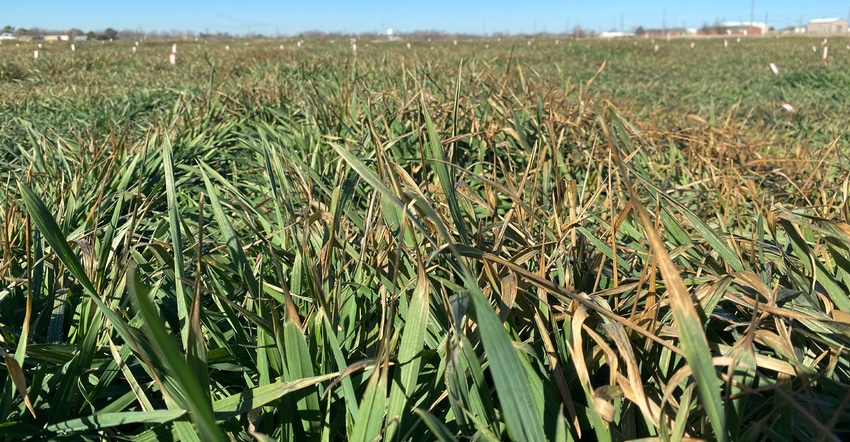
A February cold spell that saw temperatures dip as low as 22 below zero in Oklahoma’s Western Panhandle appears to have done little damage to the state’s wheat crop and livestock, according to reports from Extension specialists and the Oklahoma Department of Agriculture.
Oklahoma State University Extension economist Derrell Peel says livestock losses appear to be marginal. “I’ve checked around with my colleagues in several states and in Oklahoma,” Peel says. “It appears that death loss is pretty minimal, few losses of feedlot cattle or mature cattle.”
Amanda de Oliveira Silva, Oklahoma State Extension small grains specialist, says it’s too early to know for certain but wheat appears to have escaped the cold with mostly leaf burn.
 Amanda de Oliveira Silva, Oklahoma Extension small grains specialist, checks a wheat field for freeze damage. (Photo, Amanda de Oliveira Silva)
Amanda de Oliveira Silva, Oklahoma Extension small grains specialist, checks a wheat field for freeze damage. (Photo, Amanda de Oliveira Silva)
“The potential damage from the freeze will depend on several factors and could vary on a field-by-field basis,” Oliveira Silva says. “It might still be too early to say, but most of the things I am hearing about and seeing is that there is some leaf damage (or leaf tip burn), and the crown is looking fine.”
She says some fields had good soil moisture and received a good amount of snow cover that helped to insulate the crop and limit damage.
“I think we will have a clearer picture of the situation as the weather warms up and the plants speed up growth and development.”
Morgan Vance, chief of communications, Oklahoma State Department of Agriculture, Food and Forestry, says so far, the state statistician and others have seen no agriculture loss numbers.
Individual losses
Peel expects no significant market impact but says the livestock industry will see some losses and some individual producers may experience significant economic damage.
“I’ve heard of some losses of newborn calves, but total numbers are small. However, impacts to individual operations may be significant,” Peel says.
He expects no impact to the cattle market from cattle death loss.
“The costs are much bigger for extra feed, labor for care and lost productivity and feed efficiency,” he adds. “Most of the costs will be on affected operations rather than as market impacts.”
The extended cold period, lasting from Feb. 8 to Feb. 19, caused “some packing disruptions and reduced beef production for one week,” Peel says. “But the overall market impacts are pretty small.”
Timing was fortunate
Oliveira Silva says the freeze, if it had to happen, came at a good time for wheat. “If it had been later, damage could have been much worse,” she says.
She also notes that even with air temperatures dropping below zero, soil temperatures remained in the mid to upper 20-degree range, based on Mesonet readings.
As temperatures warm up, Oliveira Silva says, producers will get a better idea of injury.
“Injury will be easier to see when weather warms up. Look at the crown and check the color. Brown or dark is not good; translucent or green means the plant should be okay.”
She says producers may need to make a field-by-field “educated guess” on degree of damage and subsequent management decisions. It’s important, she says, to know the field and the yield potential before the freeze occurred.
Some producers might consider abandoning grain production and maintain grazing. Oliveira Silva suggests that if it’s just leaf burn, producers should consider taking the crop to harvest.
“It’s difficult to establish an injury threshold,” she adds. “Know your fields and production potential. Wheat tillers and can overcome some damage.”
If producers are grazing, she recommends removing livestock before the first hollow-stem. “Grazing past that point may reduce grain yield as much as 5% per day.”
Follow usual management
Producers should maintain routine management practices such as topdressing and fungicide application, Oliveira Silva says, unless freeze injury is severe.
“If leaf burn is the only issue, follow the regular topdressing plan,” she says. “Try to get it done before jointing.”
She says a few producers have asked if they can count on nitrogen from snowfall to augment fertilization. “Don’t rely on it for your nitrogen plans,” she says. “Follow your regular rates.”
The same holds for fungicide applications. Oliveira Silva says she was seeing some leaf rust and powdery mildew inoculum before the freeze, which seems to have killed the leaf rust but not the powdery mildew. Warmer weather could prompt a resurgence.
“Producers may need to apply fungicides, possibly twice,” she says. One application may be needed in March, a second around flag leaf. She says producers should scout the fields to make fungicide application decisions, which will depend on the weather.
Oliveira Silva says wheat producers across the state should remain vigilant as weather warms and injury symptoms become more apparent. She says some fields, especially those planted late and some with less snow cover, could show more damage.
“Watch your fields,” she says, “and be ready to react. We don’t see much injury so far.”
Wheat and cattle play significant roles in Oklahoma’s farm economy. Department of Agriculture, Food and Forestry figures show the state cattle inventory was 5.3 million head as of January 1, 2021. Wheat acreage seeded as of December 1, 2020 was 4.3 million acres.
About the Author(s)
You May Also Like






